|
Insect Monitoring In Soybean: What To Look For During Pod Fill
DR. NICK SEITER:
URBANA, ILL.
At this point in the season, most of our insect monitoring efforts are focused on soybean. There are several pests that can damage soybean during pod fill, and proper scouting is necessary to identify and, occasionally, control these insects. While not an exhaustive list, these are some of the insects and insect relatives to be on the lookout for as the growing season winds down.
Stink bugs. Stink bug (Fig. 1) feeding during pod fill (particularly R5- R6) can reduce soybean yield and quality. These insects feed directly on the developing seeds, resulting in wrinkling, shriveling, and discoloration in addition to reductions in yield. This damage can be compounded by pathogens and weather; note also that pathogen and weather-related quality issues can sometimes be confused for stink bug damage. Unfortunately, many fields in Illinois are not thoroughly scouted for insects during pod fill, and infestations sometimes go unnoticed until the crop is graded at the elevator.
The most effective way to scout for these insects is with a sweep net (my personal favorite) or a drop cloth. (Both of these methods are also effective for many other soybean pests). A sweep net (Fig. 2) is swung through the canopy perpendicular to the rows a set number of times (usually 25 “sweeps” per sample). With a drop cloth, a small section of row (usually 3 feet) is shaken vigorously over a cloth, and the insects that are dislodged from the soybean canopy are counted. An insecticide application is warranted if you meet or exceed the economic threshold, which is 9 per 25 sweeps with a sweep net or 1 per row foot using a drop cloth. Note that the window of residual activity provided by insecticides for stink bug control is short (generally < 1 week); therefore, preventative applications targeted to a certain growth stage are unlikely to be effective. The most effective applications are those that are made only when (and if) a damaging population occurs – a rare event in Illinois.
Spider mites. Unfortunately, we have struggled with drought stress in parts of Illinois in recent weeks. While not a problem every year (and not an insect), spider mites often become an issue when soybeans are drought stressed. Spider mite feeding causes yellow to brown discoloration of soybean foliage (Fig. 3), and can result in severe stress to the plant. The infestations often (but not always) begin at field edges. Closely examining infested foliage will reveal the mites and the webbing that they produce. Shaking the mites onto a white piece of paper and/or using a hand lens might be necessary, as they are quite small.
Dectes stem borer. This insect caused some unexpected damage in southern Illinois in 2018. The stem borer larva feeds on the pith inside the soybean stem. As the plant matures, the larvae can girdle stems which leads to lodging, especially in situations where harvest is delayed. While we do not have an economic threshold for this insect (or a reliable way to control the larvae with insecticides), infested fields can be identified and, where possible, prioritized for earlier harvest to reduce their potential for lodging. Adult dectes stem borers are gray, long horned beetles that can be found using a sweep net or drop cloth. The first sign of infestation by the larvae is usually “flagging” of petioles in which a dectes larva has been feeding (Fig. 4). The larvae themselves can be observed by slicing the stem in half (Fig. 5).
Bean leaf beetle. Bean leaf beetle adults (Fig. 6) tend to be both the first and the last defoliating pest to enter soybean fields. As with other defoliating insects, the decision of whether or not to treat should be made based on (1) the level of defoliation in the field (the economic threshold post-bloom in Illinois is 20 percent defoliation) and (2) the continued presence of the pest within the field. Estimate the overall percent defoliation by collecting individual leaflets throughout the field. There are now several smarphone apps available that can help you to “calibrate” your defoliation estimation skills (e.g., BioLeaf Foliar Analysis for Android) (Fig. 7).
As always, if you have any questions or are seeing anything unusual in the field, don’t hesitate to contact me. Happy scouting! ∆
DR. NICK SEITER: Research Assistant Professor, Field Crop Entomologist, University of Illinois
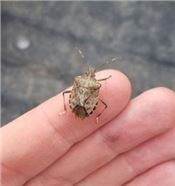
While not the most common stink bug
in soybean, the invasive brown marmorated
stink bug has been found more frequently
in Illinois over the last several years.
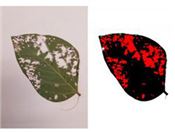
A partially defoliated soybean leaflet measured by a smartphone app; approximately 25 percent of the leaf area has been removed by insect feeding.
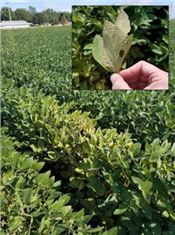
Soybean foliage discolored from spider mite damage; inset shows a close-up of the
underside of a damaged leaf, which has a “sandblasted” appearance.

A dectes stem borer larva inside of a soybean stem.
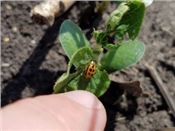
A bean leaf beetle feeding on seedling soybean foliage.
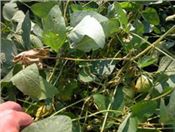
“Flagging” of a dying petiole that has been fed on by a dectes stem borer larva
image: Scott Stewart, University of Tennessee

Using a sweep net to sample insects in soybean
|
|